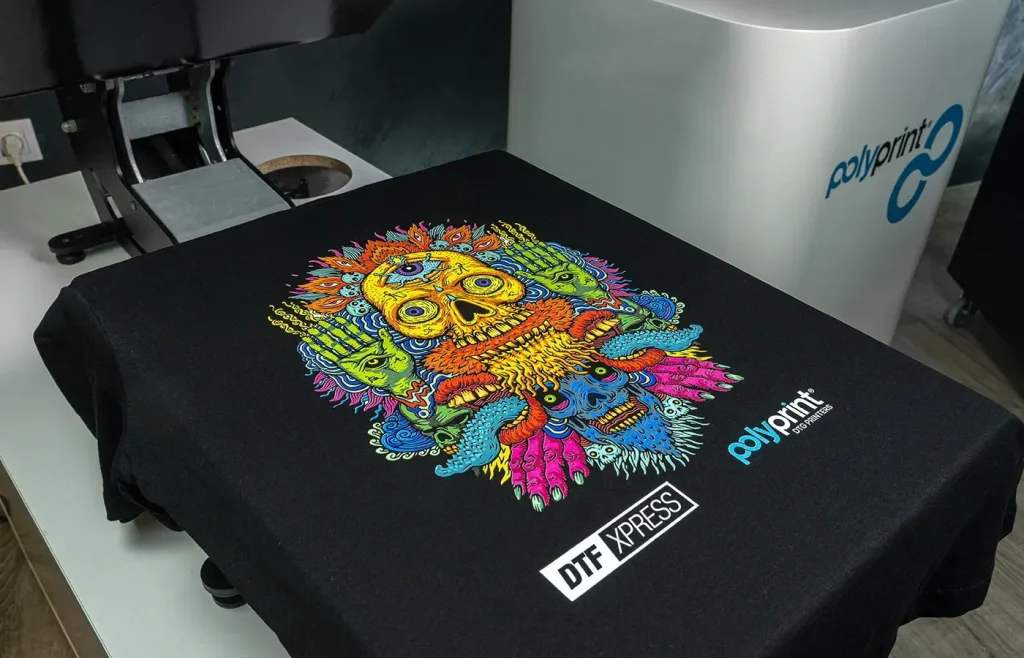DTF printing, or Direct-to-Film printing, is rapidly transforming the custom apparel industry by introducing a cost-effective and efficient way to produce stunning fabric designs. This innovative printing technology allows businesses to print high-resolution images on a variety of textiles, ensuring vibrant colors and exceptional quality that can enhance any garment. As sustainability becomes a central focus for consumers, sustainable DTF printing practices are emerging, utilizing water-based inks and eco-friendly materials, thus helping brands meet the growing demand for green solutions. With diverse DTF applications opening new markets beyond clothing, such as home décor and personalized gifts, the potential for growth is remarkable. As we delve into the latest DTF trends and innovations, it’s clear that this technology is not just a passing phase; it’s the future of printing that every business should explore.
Direct-to-Film (DTF) printing, a modern take on textile printing, leverages advanced technology to deliver high-quality results on various materials. This contemporary printing method is gaining traction due to its ability to produce vibrant designs efficiently while remaining cost-effective. As the market shifts towards greater sustainability, eco-friendly DTF printing alternatives are emerging, showcasing a commitment to reducing environmental impact. The versatility of DTF also extends to multiple sectors, indicating a significant expansion in its applications beyond conventional uses. With ongoing innovations, the DTF landscape is ripe for exploration, paving the way for new possibilities in custom design and production.
Sustainable DTF Printing Solutions
Sustainable Direct-to-Film (DTF) printing has emerged as a cornerstone for eco-conscious brands navigating the modern printing landscape. Innovative materials, such as water-based inks and recyclable films, are now being utilized to create vibrant yet environmentally friendly prints. This trend not only emphasizes the importance of reducing waste but also highlights a growing consumer preference for sustainable practices within the textile industry. Companies that adopt these strategies effectively position themselves as leaders in responsible manufacturing, appealing to the environmentally aware demographic.
The incorporation of biodegradable films further enhances the sustainability aspect of DTF printing. These films break down naturally over time, contributing less to landfills while ensuring high-quality outputs. Brands committed to reducing their ecological impact are more likely to attract loyal customers eager to support sustainable practices. Ultimately, the push towards greener DTF solutions offers a dual benefit: improving the brand’s image while fulfilling consumer demands for environmentally friendly products.
Innovative Technologies in DTF Printing
Recent technological advancements are significantly enhancing the quality and efficiency of DTF printing. A notable innovation is the development of specialized ink formulations that promote superior adhesion and durability. This means that DTF prints can maintain their vibrancy across various fabric types, withstanding washes and wear better than previous iterations. As a result, businesses can offer products that not only look great but also stand the test of time, thus providing consumers with high-value items that justify their investment.
Additionally, DTF printing technology is evolving to include machine learning capabilities that further improve the printing process. By analyzing design patterns and trends, these smart systems can optimize print settings in real-time, ensuring consistency and quality across production runs. Such integration of technology enhances operational efficiency, enabling companies to scale production while minimizing waste and errors, ultimately transforming the DTF printing landscape.
Emerging DTF Applications Beyond Apparel
While DTF printing has primarily been associated with custom apparel, its versatility is paving the way for an array of new applications. Industries such as home décor, personalized gifts, and promotional merchandise are now leveraging DTF technology to offer customized solutions that enhance consumer experiences. The ability to print on diverse substrates, including ceramics and metals, showcases DTF’s adaptability and potential for market expansion.
This growth into new markets signifies not only a diversification of revenue streams for businesses but also a newfound appreciation for unique and personalized products among consumers. As brands explore innovative applications for DTF printing, we can expect to see an upsurge in creative offerings, further solidifying DTF’s role in the future of printing technologies.
Cost-Effectiveness and Accessibility of DTF
Cost-effectiveness remains one of the most compelling advantages of DTF printing, particularly for small and medium-sized enterprises (SMEs). With recent innovations driving down both initial equipment costs and production expenses, businesses can now incorporate DTF printing methods without incurring substantial financial burdens. This economic accessibility opens doors for new entrants in the market, allowing countless creators to pursue their entrepreneurial visions through custom apparel.
Moreover, the simplicity of DTF printing processes allows for quick adoption and integration into existing operations. As the technology matures, user-friendly advancements have streamlined workflows, enabling even those without extensive technical backgrounds to create high-quality prints. This accessibility democratizes the custom apparel market, fostering a burgeoning community of designers, artists, and entrepreneurs eager to utilize DTF capabilities.
Automation with DTF: The Future of Printing
Automation technologies are revolutionizing DTF printing processes, significantly reducing labor costs while enhancing output consistency. The integration of robotics and machine learning enables manufacturers to achieve faster turnaround times, allowing them to meet the growing consumer demand for personalization and customization. This shift towards automated systems not only streamlines production but also enhances quality control, ensuring that each print adheres to stringent standards.
Furthermore, the deployment of AI technologies within DTF printing allows for adaptive learning and optimization. These systems can analyze market trends and consumer preferences, enabling businesses to adjust their offerings more swiftly. The synergy between DTF printing and advanced automation represents a transformative trend that is reshaping the industry while meeting the dynamic needs of consumers.
Community Development and Training in DTF Technology
As DTF printing technology evolves, there’s a pressing need for a skilled workforce equipped to navigate and optimize these advancements. In response, manufacturers and educational institutions are forming collaborations focused on creating robust training programs centered on DTF technology. These initiatives not only develop essential skills but also promote understanding of sustainable practices, ensuring that future generations are prepared to contribute positively to the industry.
The growth of online forums and community platforms further facilitates knowledge sharing among DTF users. These spaces encourage collaboration, offering enthusiasts and professionals a venue to share experiences, troubleshoot challenges, and exchange best practices. As this sense of community blossoms, it paves the way for continuous improvement and innovation within the DTF space, fostering a more knowledgeable and capable printing workforce.
Frequently Asked Questions
What is DTF printing and how does Direct-to-Film technology work?
DTF printing, or Direct-to-Film printing, is a modern textile printing technology that transfers designs onto fabrics using transfer films. In this process, designs are printed onto a special film, which is then heat-pressed onto the garment. This method allows for vibrant prints with fine details on various fabric types.
How does sustainable DTF printing benefit the environment?
Sustainable DTF printing focuses on minimizing environmental impact by using water-based inks, recyclable films, and biodegradable materials. These eco-friendly practices appeal to consumers who prioritize sustainability, helping brands reduce their carbon footprint while meeting market demand for greener products.
What are the latest trends in DTF applications across different industries?
The latest trends in DTF applications extend beyond apparel to include home décor, personalized gifts, and promotional products. The flexibility of DTF technology allows it to print on diverse substrates such as ceramics, plastics, and metals, creating unique and customizable products that resonate with consumers.
How is DTF printing evolving with automation and AI innovations?
DTF printing is evolving through automation and AI integration, which streamline the printing process. Automation reduces labor costs and turnaround times, while AI helps optimize design production, color matching, and trend analysis, enhancing operational efficiency and product quality for businesses.
What factors contribute to the cost efficiency of DTF printing?
Cost efficiency in DTF printing arises from lower equipment costs, enhanced printer usability, and reduced material waste. Recent innovations have made DTF technology more accessible to small and medium enterprises, allowing them to adopt this printing method without significant investment or technical barriers.
Why is training and community development important for DTF printing professionals?
Training and community development are vital for DTF printing as technology rapidly evolves. Educational programs and online forums provide individuals with essential skills and allow users to share knowledge, fostering an environment of innovation and best practices that benefits the entire DTF community.
| Trend | Key Points |
|---|---|
| Sustainability Focus | Manufacturers emphasize eco-friendly practices, including water-based inks and biodegradable films. |
| Enhanced Quality and Resolution | Higher resolutions and better ink adhesion lead to vibrant, durable prints. |
| Cost Efficiency and Accessibility | Lower equipment and operational costs make DTF accessible for SMEs. |
| Automation and Integration with AI | Robotic technology and AI streamline the printing process, reducing costs and improving efficiency. |
| Market Expansion and Diverse Applications | DTF printing expands beyond apparel to home décor and promotional items. |
| Training and Community Development | Collaboration between manufacturers and institutions to create training programs for DTF technology. |
Summary
DTF Printing is transforming the landscape of custom apparel by embracing sustainability, enhancing quality, and expanding into diverse markets. These trends highlight a future where DTF technology continues to adapt to consumer demands, ensuring that businesses can leverage its benefits effectively. With the ongoing innovations in DTF printing, the industry is poised for significant growth, offering unique opportunities for creators and entrepreneurs eager to make their mark in various sectors beyond just fashion.



